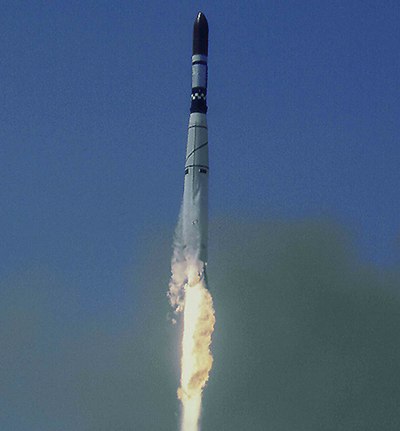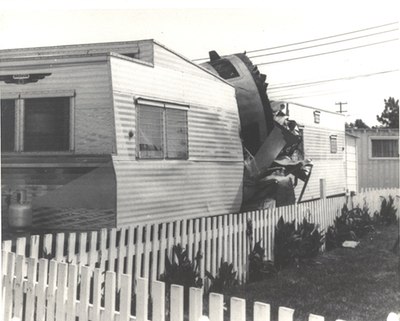The death of Frankensatby Dwayne A. Day
|
| MRPV was a collection of many experiments all crammed together atop an Agena upper stage in an awkward mishmash. It was not a pretty satellite. It was a Frankenstein’s monster. |
Throughout the history of the American military space program, the US Air Force has launched numerous unique spacecraft carrying experiments, usually to test new types of equipment or sensors or improved spacecraft components. Because it is difficult to include experiments on operational satellites with vital missions, the Air Force has often bundled them and launched them together, not always in the most elegant packaging. In 1995 the Central Intelligence Agency declassified the CORONA reconnaissance satellite program. Buried in the mountains of data the CIA released was a brief mention of a non-reconnaissance satellite that had been managed by the CORONA program office. That satellite was less of a mystery than CORONA, because over the years the Air Force had published various bits of information about it. In fact, the only real surprise was that this unclassified satellite had been included as part of the CORONA program at all and was counted by the Air Force as part of the total CORONA launches. But because it never reached orbit, it was quickly forgotten.
But like many experimental payloads, the satellite went by several designations. Some sources refer to the flight as “Agena Vehicle 1602.” But the closest it seems to have had to a formal name was the Multiple Research Payload Vehicle, or MRPV. It was a collection of many experiments all crammed together atop an Agena upper stage in an awkward mishmash. It was not a pretty satellite. It was a Frankenstein’s monster.
The MRPV was developed by Lockheed Missiles and Space Company. Lockheed integrated twenty-one experiments onto the Agena forward and aft racks, all linked with a data storage and transmission system.
The experiments consisted of the following:
Night Air Glow
Satellite High Frequency Ionospheric Project
Plasma Frequency Probe
Retarding Potential Analyzer
Erosion Gage
Rawer Probe
Magnetometer
Cosmic Ray Monitor
Vehicle Electrical Potential
Faraday Cup
Eastman Kodak Horizon Sensor
Allis Chalmers Fuel Cell
RM-12 Radiometer
RM-15 Radiometer
TV Camera
GRF-5
Air Force Cambridge Research Laboratory 573 Proton Resonance
Radio Frequency Interference
Bio-Cell
65-161 PRF Antenna
Potassium Heat Transfer
Little is known about most of the experiments carried onboard the satellite. The purpose of the Night Air Glow experiment was to observe the worldwide distribution of night airglow at 3914, 5577, 5735, and 6300 angstroms and search for any correlation with precipitating energetic particles as detected by the Faraday Cup. A Fastie-Ebert monochromator would have scanned the ultraviolet spectrum between 1600 and 3200 angstroms and made a detailed study of atmospheric day radiance in that spectral range. The x-ray detector would have studied solar x-ray enhancements during solar outbursts.
 The Multiple Research Payload Vehicle (MRPV) satellite lost in the crash. |
One of the experiments, labeled, the Satellite High Frequency Ionospheric Project, or SHIP, required deploying a small, boxy subsatellite from the main spacecraft and transmitting signals that would be collected both by ground stations and by receivers on the Agena. The “baby satellite,” mounted to the aft rack of the Agena, would be ejected so that after several minutes it would be below and moving slowly ahead of the main spacecraft. The plan was to make radio propagation measurements along the signal path between satellites, and to make measurements along the paths between the ground stations and each satellite.
The experimenters participating in the project were essentially a who’s who of organizations involved in space technology development in the mid-1960s, as well as some unexpected participants. They included Lockheed, the Aerospace Corporation, Allis Chalmers, Thompson Ramo-Wooldridge, the University of Heidelberg, Harvard University, the University of Maryland, General Electric, and others.
| A pregnant woman was at one end of the trailer and her two children were at the other. A photo of the debris shows just how lucky they were, with a large piece of rocket debris separating the two ends practically at the middle. |
On August 31, 1965, the Thor-Agena D carrying the MPRV satellite stood on launch pad 75-3-5, later designated Space Launch Complex 1, or “Slick-1,” at Vandenberg Air Force Base. Slick-1 was in fact the site of the first CORONA launch, over six years earlier, and the site of numerous ones since then. Almost all the launches at Vandenberg were given names for easy reference at a time when Vandenberg was very busy, and this one was designated “WORD SCRAMBLE.” The countdown was initiated at 7:05 AM local time and proceeded to T-1 second, when it was aborted due to a malfunction in the Rocketdyne Engine Relay Box.
The second countdown was initiated at 7:05 AM on September 2. There was a 45-minute hold imposed at T-20 minutes because of a common problem at Vandenberg: trains running through the launch area. According to a former Thor program manager, Wayne Eleazer, the winds were high that day, coming out of the west, from the ocean. But the rocket configuration was capable of dealing with high winds, as long as they were near the ground. High winds at altitude were another issue altogether.
The rocket launched and started to arc to the south. But high winds aloft pushed the vehicle east, inland. Soon it was 335 meters from its planned trajectory, and crossed over the line where the Missile Flight Control Officer was supposed to press a button sending a destruct signal to the rocket. Finally he did press the button and sent the command, but it was too late—the rocket blew up, raining debris down on an inhabited part of the base.
 The ill-fated launch of Frankensat. |
Eleazer remembers that the Thor was capable of handling high winds. One configuration had a maximum allowable ground wind speed of 139 km/h (75 knots) at liftoff. “We used to think that was ridiculous. That is hurricane velocity and it would not be safe or possible to work at the pad under those conditions.”
According to Eleazer, the debris fell on a trailer park on the base, with a large piece falling on an occupied trailer. A pregnant woman was at one end of the trailer and her two children were at the other. A photo of the debris shows just how lucky they were, with a large piece of rocket debris separating the two ends practically at the middle. Surprisingly, there was no fire. Eleazer said that according to some accounts, although the woman and children were uninjured, the woman went into labor and delivered her child five weeks early.
Eleazer said that he was originally told that the launch involved the new long tank version of the Thor, and that the safety plots were for the old, shorter version of the vehicle. The story passed on by word of mouth was that the launch director told the Missile Flight Control Officer to ignore the vehicle’s violation of the allowed trajectory lines. The MFCO refused and turned the key and blew up the vehicle, and was immediately fired on the spot for disobeying an order. “The story I was told back in the late seventies when I was Thor Program Manager turned out to be somewhat different” from what really happened, Eleazer said.
| Even after death, Frankensat’s organs continued to live on. |
What actually happened was a little more subtle, and less colorful. The vehicle was not a long tank Thor. Instead, it was the same as previous versions used for dozens of CORONA payloads launched by the same team many times before. But it did have a longer fairing, to cover the bigger spacecraft—CORONA missions did not have a fairing covering the blunt reentry vehicle mounted at the nose. “Whether the longer fairing should have required a new set of trajectory limits we do not know,” Eleazer said, “but it seems likely.” At least part of the legend might have also been true. “Reportedly, when the vehicle did cross the line after liftoff the range commander told the MFCO not to blow it at first in the hopes that it would get back on track. So the destruct action took place not on time, but late.” There is no mention of the MFCO being fired, but if he did delay blowing up the vehicle after it had strayed off trajectory—even if ordered to do so—that would have been sufficient reason.
Eleazer says that this account is from the records of the 30th Wing Historian, not the mishap report (a “mishap” is what the Air Force calls it when things unintentionally blow up). The mishap report would certainly have more details, such as the measured wind speeds. Presumably, the investigation led to changes in procedures, such as a lowering of the allowable winds at launch.
There was another odd aspect of the mission. The fuel cell was recovered, after falling from 11,000 meters (36,000 feet) when the vehicle blew up. The experiment plan called for it to operate for 50 hours in zero-g. The unit was shipped back to the Allis Chalmers company after being stored for three months following the accident. The company replaced some missing or damaged external components and then ran the unit, accumulating more than 200 hours. Surprisingly, the fuel cell’s performance actually improved during its first 50 hours of operation.
Even after death, Frankensat’s organs continued to live on.
